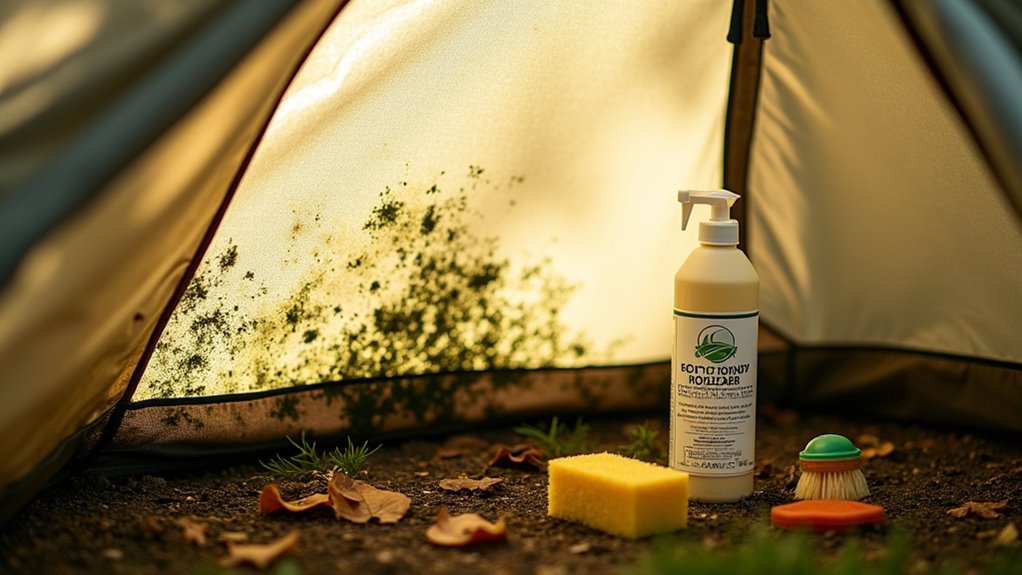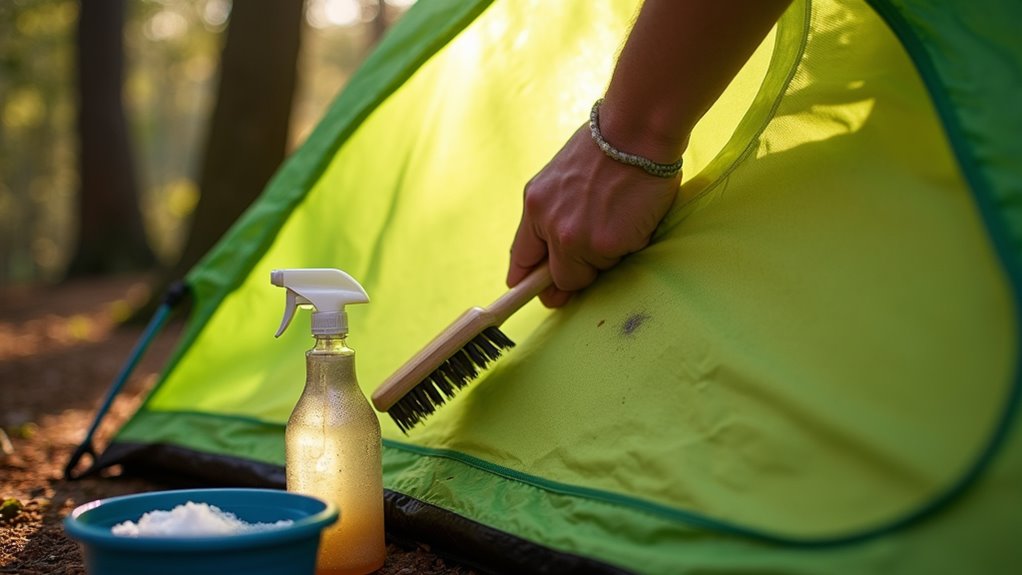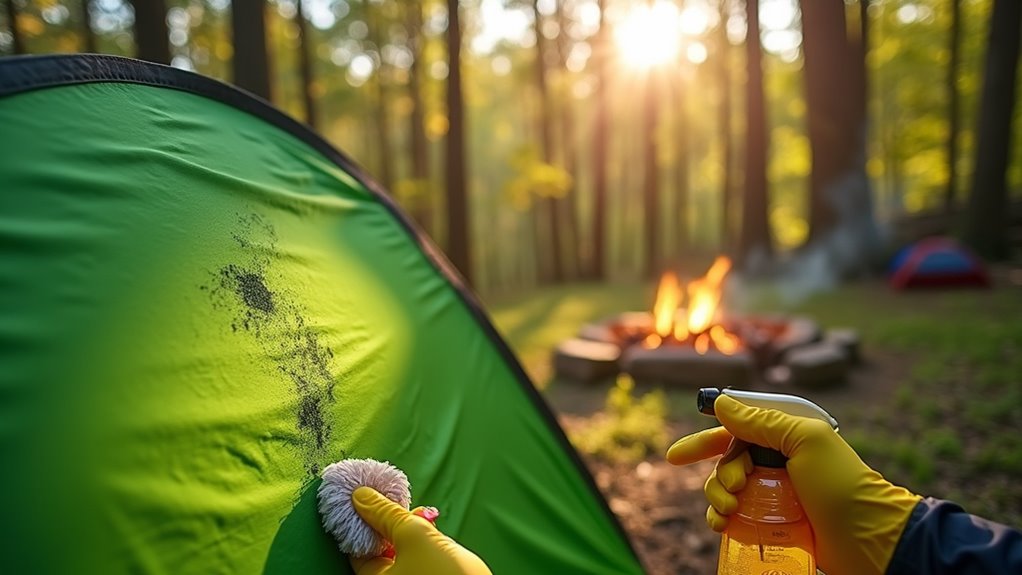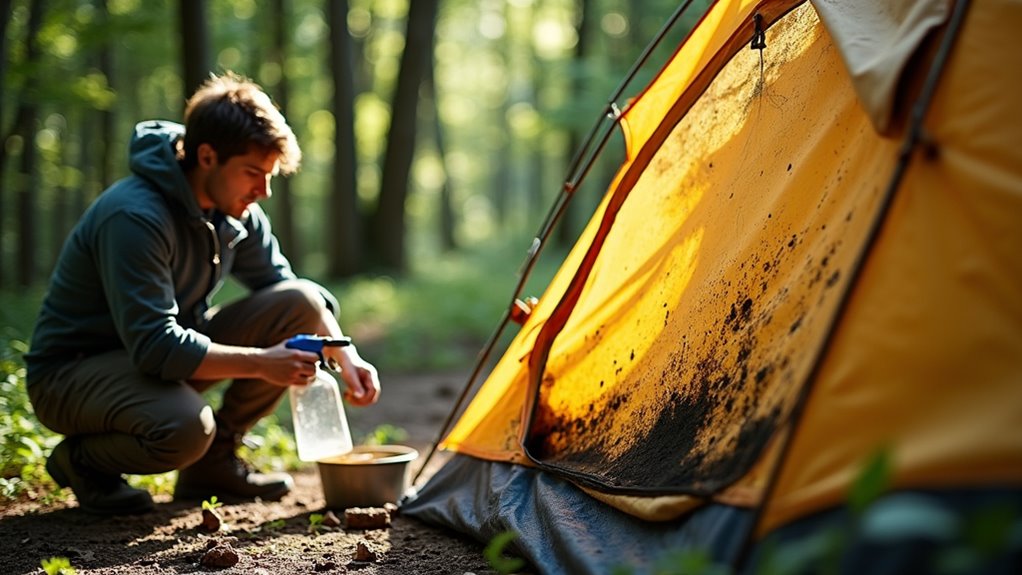How To Clean Tent Mold
This post contains affiliate links. As an Amazon Associate, we earn from qualifying purchases.
To clean mold from your tent, use a vinegar and water solution to spray and scrub the affected areas, then dry the tent thoroughly in sunlight to eliminate remaining spores. For stubborn mold, a tea tree oil mixture can be more effective. Further details on cleaning methods and prevention tips are provided below for those seeking a more comprehensive guide.
Essential Facts in 30 Seconds
- Mix half a cup of vinegar with a gallon of water, spray on mold, and scrub after 10 minutes.
- Use lemon juice and salt to scrub small mold patches.
- Apply a tea tree oil spray (two teaspoons oil + two cups water) and let sit for one hour.
- Use hydrogen peroxide sparingly on tough stains, testing first on a hidden area.
- Dry the tent thoroughly in sunlight to eliminate mold spores.
Understanding Mold and Its Causes

Mold is a fungus that damages tents fast. It grows well in wet places. Rain, high humidity, and poor airflow help mold grow. A wet tent from rain or damp packing is perfect for mold spores. These spores attack the tent fabric and cause harm.
Store your tent in a dry, cool spot. Always dry the tent completely before folding it. Check the tent often for mold, especially after humid trips. Regularly checking your tent for mold growth ensures it remains in good condition for future use.
Mold not only ruins tents but can hurt your health. People with breathing problems face bigger risks. Stop mold by keeping your tent dry and aired out. This simple care helps your tent last longer and stay safe.
Natural Cleaning Solutions for Tent Mold
Keep your tent clean to stop mold and make it last longer. Natural cleaners fight mold without bad chemicals. Try these three easy ways:
- Vinegar and Water: Mix half a cup of white vinegar with one gallon of water. Spray on mold spots. Wait 10 minutes. Then scrub. Vinegar kills mold and stops it from coming back.
- Lemon and Salt: Squeeze lemon juice and add salt. Use this mix to scrub gently. Lemon acid breaks stains. Salt acts like a soft scrub. Good for small mold patches.
- Tea Tree Oil Spray: Mix two teaspoons of tea tree oil with two cups of water or vinegar. Spray on mold. Let it sit for one hour. This cleans and stops mold from growing again.
These natural ways keep your tent safe and mold-free without harsh chemicals. Simple, strong, and safe.
Effective Spot Cleaning Techniques

Spotting mold on your tent means you must clean it fast.
First, check how bad the mold is and what type it is. Use natural cleaners like vinegar mixed with water. You can also pick a product made for mold, such as Iosso Mold & Mildew Stain Remover. Direct sunlight can also help kill mold spores during cleaning.
Apply the cleaner directly on the mold spots with a soft brush or spray bottle. Be gentle to avoid hurting the tent fabric. Cleaning soon stops mold from spreading and keeps your tent safe. Additionally, it’s important to ensure proper drying before storage to maintain tent condition.
Natural Cleaning Solutions
Fight tent mold using safe, natural cleaners that protect your gear and Earth.
Try these three strong options made from simple ingredients:
- Vinegar: Mix half a cup of white vinegar with one gallon of water. Spray mold spots, wait 10 minutes, then wipe clean.
- Tea Tree Oil: Add 2 teaspoons of tea tree oil to 2 cups of water. Spray on mold, let it sit for at least an hour, then wipe.
- Lemon and Salt: Combine lemon juice, salt, and hot water. Apply gently to mild mold spots. Avoid rubbing hard to protect fabric.
Test each cleaner on a hidden spot first. This keeps your tent safe while removing mold effectively.
Spot Cleaning Methods
Mold can damage your tent quickly. Use enzyme cleaners like MiraZyme™ or mild soap with warm water. Scrub gently with a soft brush on the mold spots.
Vinegar mixed with water works well too. Let the cleaner sit for 10 minutes before rinsing. Clean your tent on warm, sunny days to dry it faster. Make sure to ensure the tent is completely dry before storing to stop mold from coming back. Sunlight helps kill mold or mildew spores effectively during the drying process.
Check your tent after washing. Clean spots often to keep your tent strong and ready for use.
Emergency Treatment Options
Mold can ruin your camping gear fast. Act quickly to stop it. Use these simple treatments:
- Spray a mix of one part white vinegar and four parts water on mold. Vinegar kills germs fast.
- Make a paste with lemon juice and baking soda. Rub it on tough mold spots gently.
- For delicate fabrics, mix salt, lemon, and hot water. This cleans mold without damage.
Test each method on a hidden spot first. This keeps your tent safe. Regular maintenance can help prevent future mildew growth and ensure your tent remains in good condition.
Fast cleaning stops mold from spreading. Enjoy camping without mold worries!
Preventing Mold Growth in Tents

Prevent mold in tents by using materials that breathe. Fabrics that let air pass stop dampness. Good airflow keeps mold away during camping. Always dry your tent fully before packing it. A well-ventilated tent helps reduce moisture buildup, making it less prone to mold. Store it in a cool, dry place to prevent spores. Use storage bags that allow air to flow. These simple steps cut mold growth by over 70%. Regular cleaning and complete drying before storage help maintain a fresh tent. Keep your tent fresh and ready for every trip.
Tent Selection Tips
Picking the right tent helps stop mold growth, especially in wet or humid places. Silicone-coated tents keep water out better than PU coatings. This means less dampness and fewer chances for mold. Additionally, tents that have a water-resistant coating can enhance their ability to repel moisture.
Good tent design matters too. Rainflies that angle well and tight seams stop water from pooling and getting inside.
Ventilation is key. Tents with vents or mesh panels let air flow inside. This cuts down humidity and keeps the tent dry. Additionally, investing in a tent with a high waterproof rating ensures better protection against moisture, further reducing the risk of mold.
These tips make camping cleaner and more comfortable.
Proper Storage Techniques
Proper storage keeps your tent safe from mold and damage. Store your tent in a cool, dry place with good airflow. Avoid basements, attics, or garages where moisture builds up. Always dry your tent fully before packing it. Clean dirt off with a gentle cleaner. Use breathable bags instead of tight stuff sacks. These allow air to flow and stop dampness.
| Step | Action |
|---|---|
| 1 | Dry the tent thoroughly before storage. |
| 2 | Use breathable storage bags, avoiding compression. |
| 3 | Air out the tent periodically to reduce dampness. |
Following these steps helps your tent last longer and stay mold-free.
Proper Drying and Ventilation Practices
Proper drying and good airflow stop mold from growing in your tent.
Hang or spread your tent in a sunny, windy spot. Change its position often. This helps wet areas dry faster.
Open tent vents or use small fans to move air inside. Airflow cuts humidity and stops water drops from forming. These drops cause mold.
Check humidity with a simple meter called a hygrometer. Wipe wet areas after use. This keeps moisture low and protects your tent.
Dry and air out your tent well after every trip. Mold hates fresh air and dryness.
Emergency Treatments for On-the-Go Mold Removal

Mold can appear suddenly during outdoor trips. Quick action helps keep your tent clean.
Mix white vinegar and water in a spray bottle using one part vinegar to three parts water. Vinegar kills small mold spots naturally. Carry mild detergent or natural soap for gentle scrubbing. Use a soft brush or disposable microfiber cloths for cleaning.
For tougher stains, add a small amount of hydrogen peroxide. Use it carefully to avoid damaging the fabric. Hang your tent in sunlight after cleaning. Sun rays help kill mold spores.
Salt, lemon juice, and hot water also work as eco-friendly cleaners. Always dry your tent quickly and fully. Never pack your tent away while it’s wet. This stops mold from growing again.
Frequently Asked Questions
Can Mold Affect the Waterproofing of My Tent?
Mold can damage your tent’s waterproofing. It eats away at the fabric and coatings. This lets water seep inside during rain. Keep your tent dry to stop mold growth. Check it often for signs of mold or damage. Clean and dry your tent after every trip. Use waterproof sprays to keep water out. These steps help your tent last longer and stay dry. Don’t ignore mold; it weakens your tent’s protection.
How Often Should I Inspect My Tent for Mold?
Check your tent for mold after every trip, especially in damp weather. Mold grows fast in wet, warm places. A quick look inside and outside stops mold before it spreads. Cleaning your tent well and drying it fully helps too. Think of it like caring for your car to stop rust. Regular checks keep your tent fresh and ready for your next adventure. Stay safe and enjoy camping without mold worries.
Are There Specific Mold-Resistant Tent Brands to Consider?
Brands like Kodiak Canvas and MSR make tents with mold-resistant materials. These tents last longer and stay cleaner. Clean your tent often. Store it in a dry place. This stops mold from growing. Taking care of your tent keeps it strong and ready for your next trip.
What Should I Do if Mold Returns After Cleaning?
Mold can come back after cleaning. Keep your tent dry and air it well. Use mold prevention sprays or powders. Check your tent often for signs of mold. Fix any leaks or damp spots quickly. Good airflow lowers mold growth by 60%. Dry storage cuts mold risk a lot. Staying alert helps stop mold before it grows big.
Can I Use Bleach to Clean Mold From My Tent?
Bleach can harm your tent’s fabric and cause health problems. Use special mold removers instead. Natural disinfectants like vinegar or baking soda work well too. These options clean mold safely and protect your tent. Avoid strong chemicals to keep your gear lasting longer. Clean your tent gently and dry it fully to stop mold from coming back. Safe cleaning keeps your tent fresh and ready for your next trip.
Conclusion
Cleaning mold from your tent is simple and effective. Use vinegar or baking soda to remove mold safely. These common items kill mold and keep your tent fresh. Dry your tent completely after cleaning to stop mold from growing again. Good airflow helps keep moisture away and your tent dry. Regular cleaning and drying protect your tent for many camping trips. Enjoy the outdoors with a clean, mold-free tent every time. Your next adventure deserves a fresh, safe shelter!
